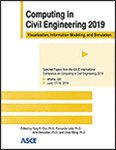ASCE International Conference on Computing in Civil Engineering 2019
Comprehensible and Interactive Visualizations of Spatial Building Data in Augmented Reality
Publication: Computing in Civil Engineering 2019: Visualization, Information Modeling, and Simulation
ABSTRACT
Visualization has shown to significantly assist communication and decision making within the architecture, engineering, construction, and operation (AECO) industry. The current visualization techniques do not incorporate the building spatial context due to lack of interaction and immersiveness. Extracting and visualizing building data are mainly focused on the statistical methods in the current practices which require user expertise to understand the information. With the advancements in augmented reality (AR) technologies, as well as sensors and Internet of things (IoT), physical and virtual worlds can now be connected to each other, allowing for real-time access to various information about the physical artifact. By integrating these technologies within smart-buildings, where real-time and historical information sensor data are available, AR tools can provide meaningful visualizations to inform occupants about their impacts on the total energy consumption. This paper proposes an approach where occupants can explore, visualize, and interact with office appliances and building systems energy consumption information by bridging the built environment data (sensor-readings) and AR technology.
Get full access to this article
View all available purchase options and get full access to this chapter.
REFERENCE
Abrahamse, W., Steg, L., Vlek, C., and Rothengatter, T. (2005). “A review of intervention studies aimed at household energy conservation.” Journal of environmental psychology, Elsevier, 25(3), 273–291.
Azuma, R., Baillot, Y., Behringer, R., Feiner, S., Julier, S., and MacIntyre, B. (2001). Recent advances in augmented reality. NAVAL RESEARCH LAB WASHINGTON DC.
Bartram, L., Rodgers, J., and Muise, K. (2010). “Chasing the negawatt: visualization for sustainable living.” IEEE Computer Graphics and Applications, IEEE, 30(3), 8–14.
Behzadan, A. H., Dong, S., and Kamat, V. R. (2015). “Augmented reality visualization: A review of civil infrastructure system applications.” Advanced Engineering Informatics, Elsevier, 29(2), 252–267.
Bittle, R. G., Valesano, R. M., and Thaler, G. A. (1978). “Energy conservation in a large mental hospital.” Administration in mental health, Springer, 5(2), 154–161.
Cairo, A. (2012). The Functional Art: An introduction to information graphics and visualization. New Riders.
Dobson, J. K., and Griffin, J. D. A. (1992). “Conservation effect of immediate electricity cost feedback on residential consumption behavior.” Proceedings of the 7th ACEEE summer study on energy efficiency in buildings, 2.
Domınguez, M., Fuertes, J. J., Dıaz, I., Cuadrado, A. A., Alonso, S., and Morán, A. (2011). “Analysis of electric power consumption using Self-Organizing Maps.” Proceedings of the 18th World Congress of the International Federation of Automatic Control, Milán.
Ham, Y., and Golparvar-Fard, M. (2013). “EPAR: Energy Performance Augmented Reality models for identification of building energy performance deviations between actual measurements and simulation results.” Energy and Buildings, Elsevier, 63, 15–28.
Hamann, H. F. (2008). “A measurement-based method for improving data center energy efficiency.” Sensor Networks, Ubiquitous and Trustworthy Computing, 2008. SUTC’08. IEEE International Conference on, IEEE, 312–313.
Holmes, T. G. (2007). “Eco-visualization: combining art and technology to reduce energy consumption.” Proceedings of the 6th ACM SIGCHI conference on Creativity & Cognition, ACM, 153–162.
Kim, S. A., Shin, D., Choe, Y., Seibert, T., and Walz, S. P. (2012). “Integrated energy monitoring and visualization system for Smart Green City development: Designing a spatial information integrated energy monitoring model in the context of massive data management on a web-based platform.” Automation in Construction, Elsevier, 22, 51–59.
Malkawi, A. M., and Srinivasan, R. S. (2005). “A new paradigm for Human-Building Interaction: the use of CFD and Augmented Reality.” Automation in Construction, 14(1), 71–84.
McCalley, L. T., and Midden, G. J. H. (1998). “Computer-based systems in household appliances: the study of eco-feedback as a tool for increasing conservation behavior.” Computer-Human Interaction, 1998. Proceedings. 3rd Asia Pacific, IEEE, 344–349.
Murugesan, L. K., Hoda, R., and Salcic, Z. (2015). “Design criteria for visualization of energy consumption: A systematic literature review.” Sustainable Cities and Society, 18, 1–12.
Riederer, P., Marchio, D., and Visier, J. C. (2002). “Influence of sensor position in building thermal control: criteria for zone models.” Energy and Buildings, Elsevier, 34(8), 785–798.
Short, M., Dawood, M., Crosbie, T., and Dawood, N. (2014). “Visualization tools for energy awareness and management in energy positive neighborhoods.”
Information & Authors
Information
Published In
Computing in Civil Engineering 2019: Visualization, Information Modeling, and Simulation
Pages: 79 - 86
Editors: Yong K. Cho, Ph.D., Georgia Institute of Technology, Fernanda Leite, Ph.D., University of Texas at Austin, Amir Behzadan, Ph.D., Texas A&M University, and Chao Wang, Ph.D., Louisiana State University
ISBN (Online): 978-0-7844-8242-1
Copyright
© 2019 American Society of Civil Engineers.
History
Published online: Jun 13, 2019
Authors
Metrics & Citations
Metrics
Citations
Download citation
If you have the appropriate software installed, you can download article citation data to the citation manager of your choice. Simply select your manager software from the list below and click Download.
